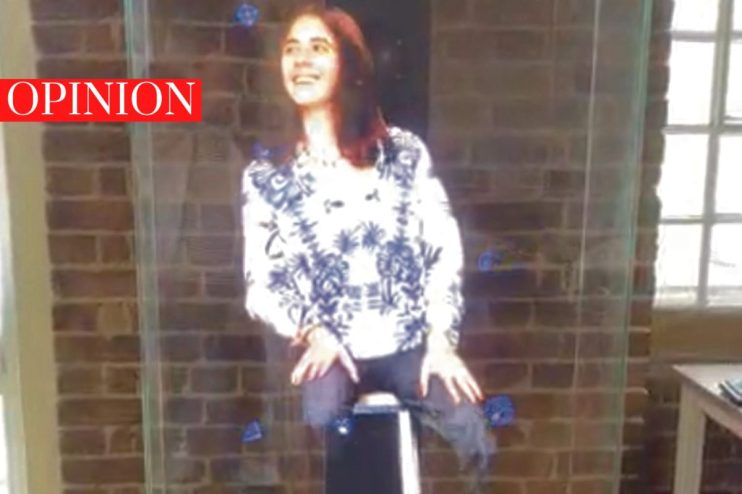I’ll be right there – or my hologram will be. The weird future of your lifesize AI boss

A hologram powered by AI? There’s a company that does that and more, from holograms of birds to a hologram of yourself to save you from board meetings, writes Elena Siniscalco
There is something special about the moment when a tiny, colourful bird flies in front of you in a park or a forest, something from the world of poetry in the way it spreads its little wings and hangs in the air. I was recently reminded of that feeling while watching the hologram of a parrot flying in front of my face. Nature with a twist of AI is what we get served these days.
In a room in London Bridge, you can find yourself surrounded by holograms of not only birds but also cars and luxury rings. There’s even a holographic Barbie logo flashing up against a wall. It’s the showroom of Hypervsn, a company producing 3D solutions for retail and other clients. In the words of founder and chief exec Kiryl Chykeyuk, they are going one step further in creating immersive content that customers want to experience. “Digital content in the end it’s going to be almost indistinguishable from physical reality”, he says. It would all fit well in a Black Mirror episode.
Hypervsn has an interesting life story, the brainchild of Chykeyuk and a friend while he was doing a PhD in machine learning at Cambridge. He started exploring the way our brain perceives things in 3D, and figured out that feeling of amazement – the same I felt while watching his digital parrot – could bring a lot of money to businesses. After participating in both Dragons’ Den and Richard Branson’s Pitch to Rich, the company is now a leader in its pioneering field, and it’s going one step further with holographic AI-powered humans.
The one they have in the showroom is called Luna, and she’s a beautiful blonde woman dressed in pink. She likes orange better though, or at least that’s what she tells me. When asked whether she likes being a woman, she says she appreciates “the unique perspective and experiences that come with being a woman”. It was all getting a bit too real, until thankfully she confirmed she is only in “the virtual world” because she is a “computer program” without a “physical location”.
Chykeyuk says the digital human doesn’t have to be a blonde, attractive woman but can take any form. Even cartoon characters for a kids’ audience. These digital avatars are being deployed as customer assistance in banks, universities and shopping malls. They are powered by the same technology behind ChatGPT, plus a series of inputs that Hypervsn gives them to have specialised knowledge. Chykeyuk says if we find an agreement on personal privacy, we could soon be in a world where a hologram welcomes you into your bank branch, calling you by name and asking you what you need.
One of their holograms is being used by a bank in Texas, another one by a university in Canada during open days. A hologram deployed in Slovakia had tens of thousands of questions asked within months. “I don’t think all these people wanted to find out some information, I think it was a lot about experience”, says the founder.
With Hypervsn technology, you can even make a hologram of yourself. It only comes at the humble price of £35,000. But it saves you from going to that board meeting you so despise. Perfect for rich people who also happen to be shy.
There is no arguing that the technology behind all of this is impressive. And it’s true that for retail, with the digital high street replacing those in our city centers, experience is becoming more important than the product itself. If Zara still wants people to come down to their shops, it has to offer them something more – as it did in its flagship store in Paris replacing mannequins with augmented reality.
Chykeyuk says that people want augmented reality to have a body and a face. “People would like to see different digital people, they would like to talk to digital people”, he says. He might be right, but I still liked the parrot better than Luna.